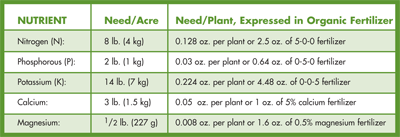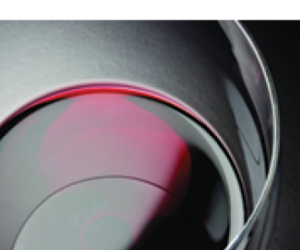This chart illustrates the average nutrients removed from soil per acre (rounded off in pounds) in a producing vineyard per year (at 2.5 tons per acre, or about 5 pounds of fruit per plant, at 1,000 plants per acre).
Note: Many backyard soils in the United States provide these nutrients naturally to the vines, year after year. This chart does not imply that all vineyards need to have these nutrients added. If your vines produce vigorous, green growth and good fruit year after year without adding fertilizer, there is no need to add further amendments or nutrients. Stunted, low-yielding or yellowed vines will benefit from nutrient additions early in the growing season, at flowering, and after harvest. Using compost or natural fertilizers can help the vine use the existing nutrients in the soil more effectively.
Over the past decade, influenced by the increasing popularity of gourmet cooking and healthy lifestyles, organic produce and wine have gained a small foothold in supermarkets, produce stands and farmer’s markets all over North America. Does the organic production of wine and food really bring out flavor and health benefits that are lacking in much of the offerings from a production agriculture system that cares more about yield and appearance than taste? Or does “organic” fit into the category of smoke and mirrors, more fluff than substance, just one more trendy way for the “earthy” set to distinguish themselves further from the mainstream? You and your wines can be the judge of that question. I will simply suggest that “organic” can be defined in the following manner: farming without synthetic fertilizers or pesticides, allowing diversity and natural competition to keep pest pressure in check and natural systems in balance, and allowing the decomposition of organic matter to provide the nutrients that a plant needs to produce a balanced crop.
Most backyard vineyards lend themselves perfectly to organic winegrape production. Grapevines commonly thrive in the United States and beyond with little or no fertilizer and chemical inputs. The challenges that face the organic vineyardist — namely, pest pressure, diseases, soil fertility, weed control (vineyard floor management) and canopy management — are much easier to manage in a small at-home vineyard than in a large commercial vineyard. Having a small vineyard at home means you can monitor each vine on a regular basis, and move swiftly to adjust to the vines’ needs.
The purpose of this article is to familiarize the WineMaker reader with the basic concepts of organic grape production, define some fundamental terms, and to suggest methods in which the viticultural practices (such as fungicide application, leaf-pulling, mowing and sowing cover crop) in backyard vineyards can be “tweaked” into alignment with organic, or sustainable, production. Organic and “sustainable” farming are a little different, and we will define and discuss the differences between these two terms a little later in the article.
The first question you should be asking yourself while reading this article is this: Will making my vineyard organic make my wine taste better? This is key. Even though I use many sustainable and organic practices in my own commercial vineyard in Santa Barbara County, California, I am a pragmatist. I understand that using natural fertilizers such as bat guano, kelp extract and fish emulsion are more expensive than their commercial counterparts. By this I mean you get a lot less organic nitrogen/phosphorous/potassium (NPK) for your money. Don’t be fooled, though. There are subtle changes that occur in the soil when you use organic fertilizers, changes that will positively impact soil structure, nutrient availability and fertility. There are reasons that I choose to use these practices, but if the philosophy did not produce measurable results, I would quickly abandon it. My grapes sell well in the marketplace and they make very fine wines, and that is proof enough for me.
Before going any further into specific sustainable and organic practices, let’s make sure we understand some necessary vocabulary:
Organic: The following definition of organic was passed at The National Organic Standards Board’s April 1995 meeting in Orlando, Florida. “Organic agriculture is an ecological production management system that promotes and enhances biodiversity, biological cycles and soil biological activity. It is based on minimal use of off-farm inputs and on management practices that restore, maintain and enhance ecological harmony. The primary goal of organic agriculture is to optimize the health and productivity of interdependent communities of soil life, plants, animals and people.”
So what does that mean to the backyard viticulturist? It means that instead of feeding the plant with synthetic fertilizers, you build the soil and the vine’s environment to strengthen the entire system that supports the vine. The key here is to limit “inputs” into the vineyard that are not sourced from organic material.
The best type of fertilizer in an organic vineyard would be material that can be produced right there at your property: home-made compost, manure and the like. The final goal of organic agriculture is to grow delicious produce while promoting healthy soils, promote diversity of animals and insects living around the farm (forming a natural balance to keep out single pest species that, unchecked, can hurt the vineyard system), and reduce our reliance on chemically-based fertilizers. Sounds easy, right?
Sustainable: Depending on who you talk to, “sustainable” winegrape production can have widely differing definitions. Some purists believe “sustainable” goes beyond organic, that everything that is used on the farm (all inputs) must also come from the farm. That means you make your own compost, use manure from your own animals, pump your own water without depleting the underground sources, perhaps even using a windmill or hydro-electric source to produce the electricity for pumps and winemaking. This is difficult to do in grape growing, as most farms I know do not have a sulfur mine to make fungicide. (Using “wettable sulfur,” or sulfur that is applied in liquid form to the vine, is generally considered an organic practice.) Personally, I would need a bat cave for the guano, and an ocean and a plant to process kelp and fish into fertilizer. That wouldn’t leave much time for farming and winemaking! For our purposes, let’s choose a more liberal definition of sustainable: a system of agriculture that attempts to keep soils healthy and viable for many future generations, reducing or eliminating erosion, soil depletion or the need for chemical inputs. Sustainable viticulture promotes soil health and hand labor (where practicable) to give the vine everything it needs to be healthy, balanced and to produce delicious wine. The sustainable farmer, even one who farms only in his back yard, should consider the sustainable creed: “environmentally sound, socially just and economically viable.”
Biodiversity: It’s hard to discuss biodiversity without sounding like a hippie, so let me throw on a quick tie-dye and get down to business. The idea here is that everything in a natural system (vineyard) is connected. Below the soil there is an amazing diversity of tiny life that breaks down organic matter into food for the vines. Spraying herbicide and making the vines dependent on chemical fertilizer negatively impacts the delicate balance of a “living” soil. A soil that is fed with organic nutrients and is kept free from herbicide will have more biodiversity, and may be more likely to fight off pressure from soil-borne pests and diseases. Many proponents of organic viticulture also point out studies that show healthy soils also help a vine stave off mildew infections and vineyard pests.
Above ground, diversity is just as important. Applying insecticide may seem like a wise move to fight off a vineyard pest such as the glassy-winged sharpshooter (I will admit that, as a last resort, spraying has been effective in ridding commercial vineyards of this pest), but by destroying all insect life in your vineyard, you have also killed all the predators that could have kept the sharpshooter population in check naturally. There is a tiny parasitic wasp native to the Central Coast of California that will lay its eggs in up to 90 percent of sharpshooter egg masses, severely limiting the pest’s ability to breed. This is diversity at work. With a balanced, diverse habitat filled with animals and insects, no single pest can do too much damage because they are too busy competing and eating one another.
Making organic models work in your home vineyard
Following are some practical tips on how to use organic growing methods in your backyard vineyard.
1. Don’t change overnight. If you have a tried-and-true method for growing quality fruit, it would be wise to make changes slowly. If there is a synthetic fungicide that is necessary to keep your fruit clean after flowering or berry-softening, giving it up may result in poor fruit quality. Science certainly produces some wonderful products that are very effective for specific applications. For example, I don’t use sulfur in my vineyard after berry-softening to stop mildew, as it will end up in the must and produce sulfur-stink (H2S). I tried some organic alternatives (potassium bicarbonate) and found that the control was fairly unreliable. So I made the choice to use a strong synthetic fungicide that was so effective it only needed to be sprayed every 20 days. (The sustainable fungicide needed to be applied weekly.) This means I am using one-third the diesel fuel, one-third the labor, putting less hours on the tractor and causing less compaction in the vineyard (yes, tractor wheels cause compaction!) That trade-off was worth it to me. Knowing that the synthetic fungicide had no impact on animal and insect life, and was safe for my family, workers, and pets made the decision even easier. If you choose to make a change over to sustainable grape growing methods, make your move one practice at a time. Never do anything that will risk your crop, because bringing in healthy fruit is what it’s all about, organic or not.
2. Build your soils with organic matter to reduce your dependency on fertilizers. Healthy soils that are full of biological activity help the vines in many ways. As mentioned before, kelp, bat guano, chicken and turkey manure can all help build soils and add organic nutrients to poor soils that produce stunted vine growth. Vines that are grown in balanced, active soils have an easier time rooting and tolerating stresses during the growing season, such as heat spikes. But be careful. Adding too much nutrient may make the vine overly vigorous, which can actually make mildew and rot pressure stronger because the grapes are buried in layers of leaves. Vines that are grown in soils containing ample organic matter can regulate their own intake of nutrients, instead of being inundated a few times a year with a strong concentration of chemical fertilizers. If you believe that your soils are infertile and not providing enough nutrients to the vines, build the soils with organic compost and organic fertilizers, which will stimulate the soil’s own decomposition and natural nutrient cycles.
3. Observe the vineyard as often as possible. The sooner you recognize a problem in your vineyard, the more choices you have for fixing it.
Many agricultural chemicals are designed for the farmer who wants a “quick fix.” There’s something wrong in their field and they want to see a change immediately. As all of us know, the more preparation and foresight that goes into any decision, the better the result will be.
Organic growing is no different. Hoeing weeds before they go to seed will help reduce pressure in subsequent vintages. By the same lights, applying fungicide (sulfur) on a regular schedule (once a week, or every 10 days) will reduce the mildew pressure so more drastic materials are not needed. Using a weather station to track weather patterns, and using that data to schedule sulfur applications, is another method to improve efficacy of inputs. (Davis Instruments makes excellent weather-stations that feed information directly to your PC through wireless technology, and they are surprisingly affordable.)
Building your soil fertility organically over many years may provide the vine a healthier root environment than dumping a heap of synthetically-derived nitrogen on it once per year. Remember that organic viticulture requires more planning and observation than chemical-based models, and that’s one reason it can produce better fruit. Taste the wines made from the vines and try to make a correlation between wine quality, vintage and your viticultural practices. Allowing the vine to use naturally decomposed organic matter as fertilizer, in my estimation, will help your wines reflect the true environment and “terroir” in which they are grown.
Some organic “tricks of the trade” that encourage foresight over chemical fixes:
1. Toss a (gloved) handful of broken glass shards into each hole as you plant your vines. This is a natural barrier for gophers. Even though the gophers will still be able to nibble the roots as they grow, the ‘crown’ near the vine’s base should stay protected.
2. Save your lawn clippings, egg shells, vegetable matter and compost it for use in the vineyard. Pile it up and turn it over every week until it looks uniform and dirt-like. Throw a handful of compost around the base of each vine each year to stimulate the soil’s biological activity.
3. Mulch your vine rows to keep moisture in and to stop weeds from growing. Black-plastic sheeting (or even cut trash bags or old carpet) under the vine row warms the soil and eliminates weed pressure. Mow between the rows before weeds go to seed.
4. Pull leaves and excessively vigorous side-shoots (secondary shoots with no fruit) from the fruiting area to open the canopy to light and wind, which will reduce mildew and make fungicide or sulfur applications more effective. Be careful not to leave the clusters so exposed that they burn, split or raisin.
5. If there are issues with erosion in your vineyard, plant a cover crop of deep-rooting grasses in the spring. Add legumes and clovers if you want to add a little nitrogen to your soil. Throw in some wildflowers appropriate for your locale and beneficial insects will voluntarily arrive, adding diversity to your vineyard.
Remember: Knowledge is organic! Search the Internet and build your library. The more you know, the less you will have to depend on heavy applications of inputs to solve your problems in the vineyard.
The key here is growing great wine. Find a comfortable balance of vineyard practices that make the process pleasurable, successful, and if possible, sustainable.





